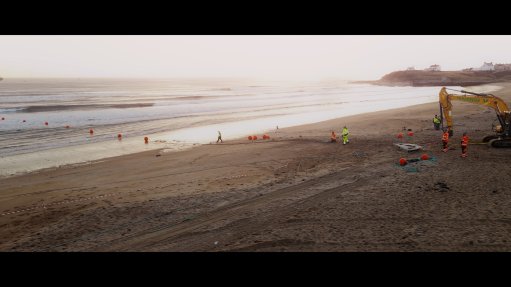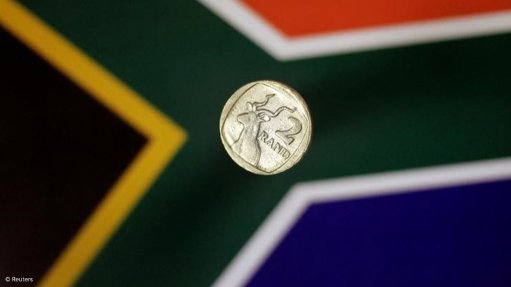The essential business of bees
This article has been supplied.
The apple trees are in blossom, whispering their pink-white promises to the bees. But the bees need no promises – they already know where they can satisfy their pollen, and nectar needs as they emerge purposefully from hives throughout the orchards.
The hives appear to be randomly placed but it is an exact science. The beekeepers bring them in mainly from the Overberg to the Elgin and Grabouw regions of the Western Cape to pollinate the pear and apple blossoms from September to the end of October each year. Elgin and Grabouw provide over 80% of South Africa’s apples and pears, while the Langkloof Valley in the Eastern Cape provides 20%. About 50% of the annual apple and pear harvest is exported.
The beekeepers know exactly how many hives they need for the fruit trees, with each hive optimally housing 30 000 Cape honeybees (Apis mellifera capensis). 'Cape honeybees – or just honeybees as we call them – have given my family everything we have,' says Danie Vorster, Founder and Head of the Overberg Honey Company, together with his wife, Nadia, whose father taught them about beekeeping.
About 120 million honeybees in managed hives
They started their company 14 years ago and it has grown into a significant operation with approximately 120 million honeybees in managed hives that are used primarily for fruit pollination. But the company also serves as a second business for honey production. Danie Vorster shared this astonishing fact: To produce 1 jar of honey, the honeybees must visit 2 million flowers. And 1 bee produces 1 drop of honey in its lifetime of 45 days.
Honeybees are prolific, indigenous pollinators that provide an essential agricultural ecological service. ‘In South Africa, over 50 agricultural crops that are essential for food and job security, and worth over R10.3 billion per annum to our economy, are pollinated by honeybees,’ explains Shelly Fuller, who is leading a Nedbank-funded World Wide Fund for Nature (WWF) Nedbank Green Trust project. The project is aimed at conserving the Cape honeybee (Apis mellifera capensis) in the Cape Floral Kingdom of the Western Cape through sustainable hive management and indigenous forage restoration.
The crops that honeybees pollinate include apples, pears, lucerne, sunflowers, macadamias, and stone fruits such as peaches, apricots, nectarines and plums. 'Caring for honeybees is critical for their survival and for ours, and this uniquely South African species is starting to get the recognition it deserves,’ says Fuller.
Not enough natural forage for the honeybees
A major issue is that there is no longer enough natural forage for the honeybees. ‘With the honeybee as a champion species for biodiversity in the Cape Floral Kingdom, this project is critical as it is focused on regenerative farming practices as a way of bringing biodiversity, including the honeybee, back to our farms and agricultural landscapes,’ says Poovi Pillay, Executive Head of Corporate Social Investment (CSI) at Nedbank.
Fuller explains that with the current agricultural footprint, there are not enough honeybees in the natural environment to pollinate all the fruit trees in the blossom period. An industry of portable hives, managed by beekeepers, is therefore an essential service to the fruit farmers. Pollination is an ecosystem service – or a service from nature – that the farms require to have successful fruit set.
‘We work with the fruit farmers and beekeepers in the fynbos and fruit-growing areas of Elgin, Grabouw and the Langkloof, focusing on apples and pears as they are reliant on managed bee hives,’ says Fuller. ‘The longer-term goal is to establish regional indigenous replanting projects that provide food for the honeybees and other beneficial insects and wildlife.’
Danie Vorster explains that one of several issues they need to factor in with regards to hive numbers is the weather, as honeybees work best when it’s warm. ‘In cold weather, about 60% of the bees need to remain in the hive,’ he explains, ‘and because the fruit pollination is done mainly in the cooler months, we need to ensure that we have enough hives in the orchards.’
The importance of honeybees for life, food and job security
Together with the South African Bee Industry Organisation (SABIO) and the Western Cape Bee Industry Association, the project team is assessing the value of honeybee pollination ecosystem services to agriculture, while also raising general awareness about how important honeybees are for life, food and job security.
The project team is working with a number of conservation organisations, including the South African National Biodiversity Institute (SANBI) and Living Lands, to assess how much indigenous forage is needed to sustain Cape honeybee populations in the natural environment outside of the agricultural pollination season.
The Langkloof is important for this as it is both a fruit and biodiversity hotspot, with intensive agriculture in a valley that is surrounded by a protected environment in the fynbos-rich mountains. ‘We are working with Living Lands here to assess this area as it provides the most natural system we can look at in terms of agriculture in nature. Beekeepers manage the hives in situ and there is good forage to help sustain the bees outside of the apple and pear pollination season.’
Bees forage in a radius of 1–3 km. To expand this radius by increasing indigenous forage for the bees in Elgin and Grabouw, the project team is building on all the work being done to remove invasive alien vegetation, with numerous fruit and wine farmers supporting the initiative.
Over 60 fruit and wine farmers are Conservation Champions
Over 60 fruit and wine farmers (most do both) in the greater Cape Winelands Region are Conservation Champions. The WWF Nedbank Green Trust helped to establish this WWF initiative in 2004 as a partnership with wine farmers who commit to biodiversity-friendly and regenerative farming practices, conserving their natural fynbos areas and improving their water and energy efficiencies.
These Conservation Champions all use the distinctive sugarbird and protea logo on their wine bottles so that buyers and consumers can support these environmental leaders. Honeybee conservation is part of this, such as Boland Cellar’s Trees for Bees Programme. With Nedbank’s support they can commit a portion of their wine sales to planting indigenous trees as forage for the honeybee.
A longstanding Conservation Champion and one of South Africa’s most sustainability-focused farms is the 2 400 hectare Paul Cluver Family Wines Estate https://cluver.com/sustainability/. Paul Cluver Senior has led the way for this over many years. Today, 1 000 hectares are committed to fynbos wilderness area, where a feast of the Cape Floral Kingdom’s over 9 000 species can be seen. More than 800 endemic trees have also been planted as part of their commitment to landscape rehabilitation. Ongoing activities like invasive alien tree removal create additional income for people in Elgin who cut and sell the wood.
We are experiencing climate change first-hand
'About 20 years ago biodiversity was a foreign concept and we weren’t focused on climate change,’ says Paul Cluver Senior. ‘This has all changed. We are now experiencing climate change firsthand, and biodiversity has become a well-known concept. The 2 are intertwined, and it is essential that we focus on regenerative farming and landscape conservation.’
Many of the Conservation Champions are now planting cover crops such as grasses and legumes between the vines, or allowing the natural vegetation to grow here to add life to the soil and increase the honeybee forage. ‘It has been shown that this practice actually improves the pollination of the fruit trees,’ says Fuller, adding that the farmers also make sure they avoid spraying chemicals during pollination.
Out-of-season eucalyptus forage
Out of season, in addition to fynbos, a key source of non-agricultural forage for the honeybee is the invasive alien eucalyptus or 'gum tree'. These trees are vital for sustaining honeybees in the late summer months throughout South Africa. However, the trees use up to 12 times more water than indigenous species. They also pose a fire risk and have extensively invaded catchment areas and rivers.
To support water security efforts, there have been widespread removals of eucalyptus trees and other invasive alien species over the past decade. This caused a massive outcry from the beekeeping industry, resulting in a revision of some of the regulations in 2014. The revision identified specific eucalyptus species that could be left intact while other species needed to be removed from sensitive areas, including river courses, dams, wetlands and estuaries.
‘A lot of work in clearing invasive alien plants from the river courses has already been done. Farmers and landowners now need assistance with the process of replanting indigenous species, which requires specialist knowledge,’ Fuller explains.
Corridor of indigenous vegetation
‘We are aiming at creating a corridor of indigenous vegetation along the river areas by way of a replanting project. This project is in collaboration with the fruit and wine farmers and with assistance from The Table Mountain Fund, which supports Cape Floral Kingdom conservation projects.
One of the key species found in the river areas is palmiet, an indigenous buffer plant that cleans the water as well as stabilises and slows down the river flow. The absence of indigenous buffer plants leads to absolute devastation in the orchards and landscape, as we have seen in the recent floods.
The project team has established and is building up indigenous nurseries, which also creates additional jobs. With input from fynbos ecologists and horticulturists they are looking at which species are the easiest to kick-start an indigenous biodiversity return with, and they are identifying species that are the favourite forage of the eminently deserving honeybee.
Article Enquiry
Email Article
Save Article
Feedback
To advertise email advertising@creamermedia.co.za or click here
Comments
Press Office
Announcements
What's On
Subscribe to improve your user experience...
Option 1 (equivalent of R125 a month):
Receive a weekly copy of Creamer Media's Engineering News & Mining Weekly magazine
(print copy for those in South Africa and e-magazine for those outside of South Africa)
Receive daily email newsletters
Access to full search results
Access archive of magazine back copies
Access to Projects in Progress
Access to ONE Research Report of your choice in PDF format
Option 2 (equivalent of R375 a month):
All benefits from Option 1
PLUS
Access to Creamer Media's Research Channel Africa for ALL Research Reports, in PDF format, on various industrial and mining sectors
including Electricity; Water; Energy Transition; Hydrogen; Roads, Rail and Ports; Coal; Gold; Platinum; Battery Metals; etc.
Already a subscriber?
Forgotten your password?
Receive weekly copy of Creamer Media's Engineering News & Mining Weekly magazine (print copy for those in South Africa and e-magazine for those outside of South Africa)
➕
Recieve daily email newsletters
➕
Access to full search results
➕
Access archive of magazine back copies
➕
Access to Projects in Progress
➕
Access to ONE Research Report of your choice in PDF format
RESEARCH CHANNEL AFRICA
R4500 (equivalent of R375 a month)
SUBSCRIBEAll benefits from Option 1
➕
Access to Creamer Media's Research Channel Africa for ALL Research Reports on various industrial and mining sectors, in PDF format, including on:
Electricity
➕
Water
➕
Energy Transition
➕
Hydrogen
➕
Roads, Rail and Ports
➕
Coal
➕
Gold
➕
Platinum
➕
Battery Metals
➕
etc.
Receive all benefits from Option 1 or Option 2 delivered to numerous people at your company
➕
Multiple User names and Passwords for simultaneous log-ins
➕
Intranet integration access to all in your organisation


















